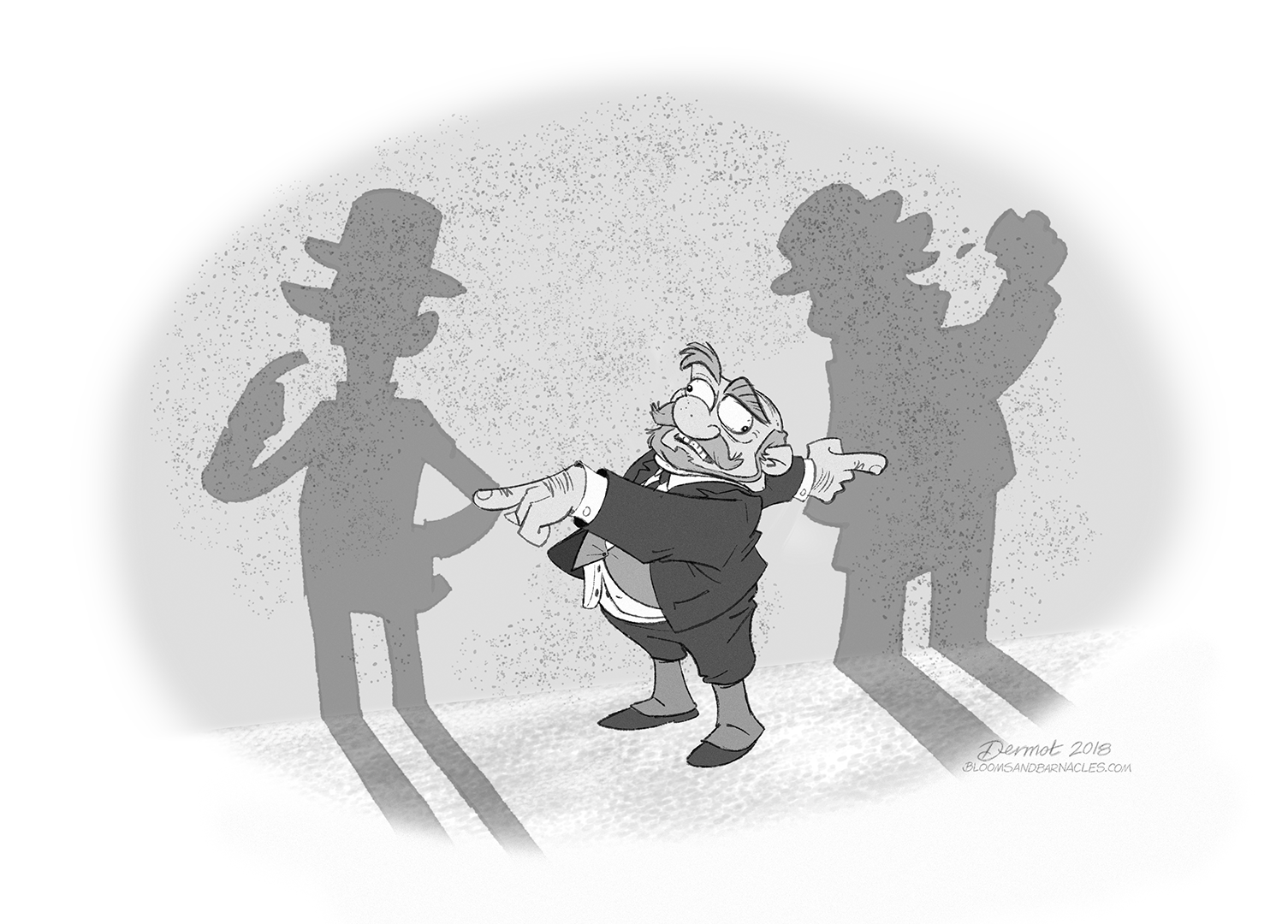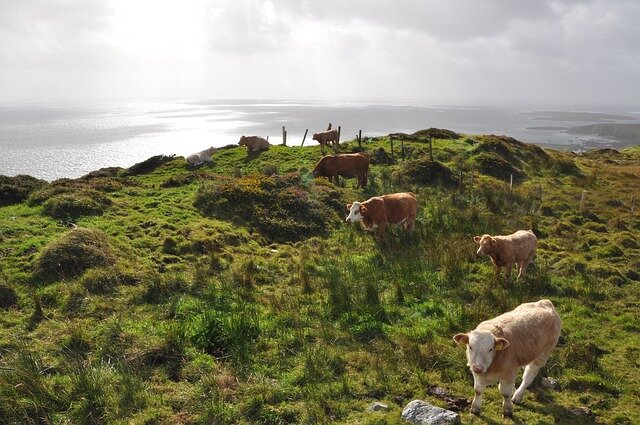Who was the Real Mr. Deasy?
"You will see at the next outbreak they will put an embargo on Irish cattle. And it can be cured. It is cured. My cousin, Blackwood Price, writes to me it is regularly treated and cured by cattledoctors there."
Discussing the real-life counterpart of Mr. Deasy, the headmaster of the school where Stephen Dedalus works, is a bit more complicated than characters like Buck Mulligan or Haines for the simple fact that he has no one-to-one correspondent in James Joyce’s life. Rather, Mr. Deasy is a mélange of two people from Joyce's life.
Much like Stephen, Joyce briefly taught at Clifton School in Dalkey, an affluent suburb to the south of Dublin near Sandycove, home to Joyce’s Martello tower. Clifton School was originally housed in Summerfield Lodge on Dalkey Ave. and later moved to a house called Cintra, found on Vico Road on the far side of Dalkey. Joyce’s tower roommate Oliver St. John Gogarty (the real-life Buck Mulligan) wrote that Joyce took the job at Clifton School to finance their bohemian experiment in the Martello tower. Joyce being Joyce, however, originally had a more grandiose scheme. Thus spake Gogarty:
He had, at first, thought of forming himself into a company, the shareholders in which were to receive all the proceeds from his future writings. The idea was novel. The shareholders would have to keep and humor him…. There were worse investments than in James Joyce, Inc.
The headmaster and founder of Clifton School, Francis Irwin was a Trinity-educated, pro-British Ulster Scot, so it’s easy to see the parallel to Mr. Deasy. The name “Deasy” is likely taken from the Landlord and Tenant Law Amendment (Ireland) Act 1860 which was heavily promoted by the Attorney-General for Ireland, Rickard Deasy. As such, it ended up being nicknamed Deasy’s Act. Touted as land reform, Deasy’s Act imposed draconian land regulation laws that heavily favored the rights of landlords over tenants. That is, pro-English, anti-Catholic landlords.
The nod to Deasy’s Act creates a framework for the character of Mr. Deasy, and lets a keen reader know that Stephen (and Joyce) views his headmaster as an oppressor. Additionally, it allows him to draw a connection implicitly between Mr. Deasy and the English student Haines, who Stephen flashes back on while he and the headmaster speak. But Irwin really is only a thematic framework on which to hang this character. Some key details of Irwin’s biography (that he was a bachelor while Deasy was a “grass widower” and that his alcoholism lead to the closure of Clifton School) are absent from the characterization of Mr. Deasy.
If Irwin is Mr. Deasy’s crunchy candy coating, then his chocolatey core is formed by a comrade of Joyce’s in Trieste, Italy. Henry Blackwood Price, assistant manager of the Eastern Telegraph Company, was an Ulsterman who had a deep, abiding concern with both his noble heritage as well as foot and mouth disease. In 1912, Price urged Joyce to use his journalistic contacts in Dublin to get a letter about foot and mouth disease published in the Evening Telegraph, a scenario identical to Deasy’s request of Stephen in “Nestor.”
Foot and mouth disease was so rampant in Ireland in 1912 that England had placed an embargo on Irish cattle, which was devastating to the Irish economy. Price had heard of a cure for foot and mouth disease in Austria and believed exporting it to Ireland could end the plague and lift the embargo. Price needed Joyce to help him get the address of William Field, an M.P. who was president of the Irish Cattle Traders’ Society. Just as Stephen aids Mr. Deasy, Joyce forwarded Price’s letter to Field, and it was subsequently published in the Telegraph.
Joyce telegraphs in numerous ways the connection between Price and Deasy (see what I did there?). Price wrote to Joyce in 1912:
Be energetic. Drop your lethargy. Forget Leinster for Ulster. Remember that Sir John Blackwood died in the act of putting on his topboots in order to go to Dublin to vote against the Union. You will get your name up if you write this up.
The first portion of this has been interpreted by Terrence Killeen of the Irish Times as meaning Joyce should eschew the “passive” attitude of the South (Leinster is the southeastern province of Ireland) for the active practicality of the North (Ulster is the northern province of Ireland) when it came to curing foot and mouth. Sir John Blackwood was Price’s most esteemed ancestor who was offered a noble title in exchange for voting in favor of the Act of Union in 1800, which absorbed Ireland into the rest of the United Kingdom. BUT Blackwood was determined to vote against Union, even unto his own death.
I imagine Price thought this anecdote would stir Joyce’s patriotism, though, in reality, Joyce held a much more cynical view of the exploits of landed Protestants. Joyce wrote to his brother Stanislaus, “I think Price ought to look for a cure for the foot and mouth disease of Anna Blackwood Price.”
Joyce did help Price get his letter published, though, and went on to publish his own editorial in the Freeman’s Journal on the political ramifications of the foot and mouth disease outbreak that same year. The experience left enough of an impression on Joyce that it found its way into Ulysses. Mr. Deasy tells Stephen:
—I have rebel blood in me too, Mr Deasy said. On the spindle side. But I am descended from sir John Blackwood who voted for the union.
Mr. Deasy, like Price, claims descent from Sir John Blackwood. Confoundingly, Deasy characterizes his ancestor as both a rebel and as having voted for the Union, which seems like a contradiction. We know that Price told Joyce the exact opposite, that Blackwood had died in the attempt to vote against the Union. Mr. Deasy reveals throughout his chat with Stephen that his memory for historical details is tenuous at best, including details about his own family history.
—Per vias rectas, Mr Deasy said firmly, was his motto. He voted for it and put on his topboots to ride to Dublin from the Ards of Down to do so.
The Ards of Down (or Ards Peninsula) in red
Here again we see the details of Price’s story intermingled with details about Blackwood. “Per via rectas” was indeed Blackwood’s motto (“by straight roads” in Latin, fitting for the conservative headmaster), and the Ards of Down is the peninsula in County Down where Blackwood’s lands are found.
Foot and mouth disease. Known as Koch's preparation. Serum and virus. Percentage of salted horses. Rinderpest. Emperor's horses at Murzsteg, lower Austria. Veterinary surgeons. Mr Henry Blackwood Price. Courteous offer a fair trial. Dictates of common sense. Allimportant question. In every sense of the word take the bull by the horns. Thanking you for the hospitality of your columns.
Here, thoughts dash through Stephen’s mind as he scans Deasy’s letter. Here we see details taken directly from Price’s 1912 letter, chiefly the mention of the emperor’s horses at Murzsteg, lower Austria, veterinary surgeons and, of course, Mr Henry Blackwood Price himself.
—I want that to be printed and read, Mr Deasy said. You will see at the next outbreak they will put an embargo on Irish cattle. And it can be cured. It is cured. My cousin, Blackwood Price, writes to me it is regularly treated and cured in Austria by cattledoctors there. They offer to come over here. I am trying to work up influence with the department.
This passage directly references Blackwood Price, and we learn that he is Deasy’s cousin. It’s all there - cattle embargo, the cure available in Austria and the effort to get high-level influence to bring the cure to Ireland.
And finally, a few pages later, Mr. Deasy says to Stephen:
I wrote last night to Mr Field, M.P. There is a meeting of the cattletraders’ association today at the City Arms Hotel.
Cows, I win.
There is a bit of fabricated history in this passage, too. While there was a terrible outbreak of foot and mouth disease in 1912 in Ireland, in 1904 the nation’s cattle were untouched by the malady. Joyce drew heavily on history, politics and especially his own biography to craft characters and situations in Ulysses, but he was never above a bit of good old-fashioned fabrication and alternative facts. If he needs Sir John Blackwood to be a Unionist, then he becomes one. If there needed to be foot and mouth disease in 1904 to push his story ahead, then so be it. As Killeen points out in his Irish Times article, getting this letter published is one of the few productive things that Stephen accomplishes on the 16th of June 1904.
Further Reading:
Ellmann, R. (1959). James Joyce. New York: Oxford University Press.
Gifford, D., & Seidman, R. J. (1988). Ulysses annotated: Notes for James Joyce's Ulysses. Berkeley: University of California Press.
Gogarty, O. (1948). Mourning became Mrs. Spendlove and other portraits grave and gay. New York: Creative Age Press.
Killeen, T. (2001, April 14). Foot-and-mouth-and-Joyce. The Irish Times. Retrieved from https://www.irishtimes.com/news/foot-and-mouth-and-joyce-1.301729
Nicholson, R. (2015). The Ulysses guide: tours through Joyce’s Dublin. Dublin: New Island Books.
Norburn, R. (2004). A James Joyce chronology. New York: Palgrave Macmillan. Retrieved from https://tinyurl.com/y55v6e3p
Historic photo of Dalkey from the National Library of Ireland archives. Retrieved from https://tinyurl.com/y3zklsgf




